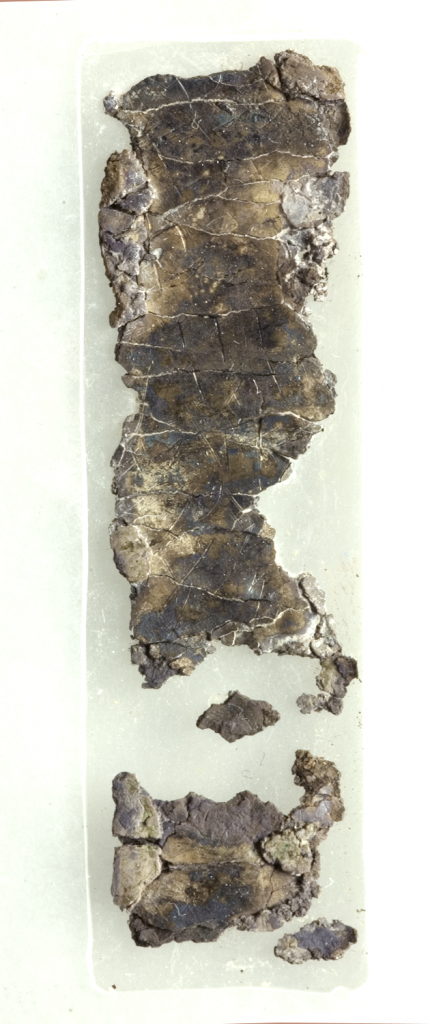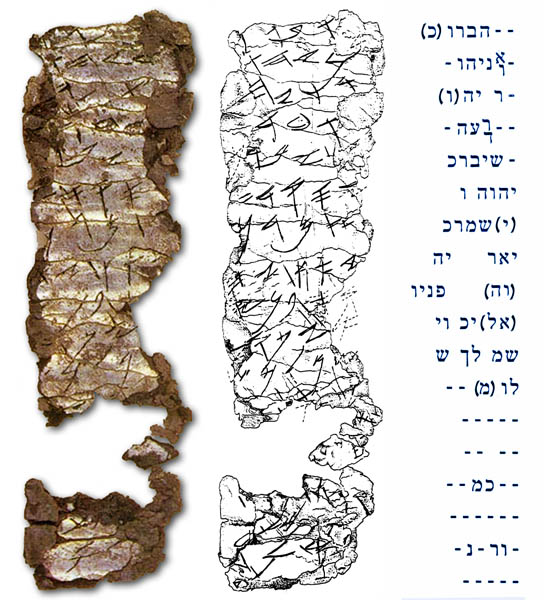 Many archaeology finds are named after the location in which they are found. The Ketef Hinnom scrolls are from Ketef Hinnom which is southwest of old Jerusalem, in Israel. More specifically they were located near the road that runs between Jerusalem and Bethlehem. They are possibly the oldest manuscripts currently known that recite what appears to be clear biblical verses.
Many archaeology finds are named after the location in which they are found. The Ketef Hinnom scrolls are from Ketef Hinnom which is southwest of old Jerusalem, in Israel. More specifically they were located near the road that runs between Jerusalem and Bethlehem. They are possibly the oldest manuscripts currently known that recite what appears to be clear biblical verses.
They are often referred to as amulets at they are were likely worn around the neck of whoever owned them. The idea behind an amulet is that some object on your body could ward off evil or danger. However, they are also still scrolls as they were sheets to silver rolled up. This idea is reinforced by the fact that the scripture that could be read are clear verses about the Lord preserving His people. The specific passages were part of the priestly blessing that Jewish priests would recite over the people. The same blessing is still common today at the end of many church services, such as the Lutherans.
24 “The Lord bless you and keep you;
25 The Lord make His face shine upon you,
And be gracious to you;
26 The Lord lift up His countenance upon you,
And give you peace.”’
(Numbers 6:24-26)
The dating of the amulets are believed to be about 6th century BCE. Their survival is partly due to the material that was used to create them. The amulets were inscribed on silver which is not the most resilient metal but enough that it was able to survive longer than the average piece of parchment.
Hebrew Translations by Jeff Benner (including Ketef Hinnom)
Kate Hinnom Scroll 1
- …] YHW …
- […]
- the grea[t … who keeps]
- the covenant and
- [G]raciousness towards those who love [him] and (alt: [hi]m;)
- those who keep [his commandments …
- …].
- the Eternal? […].
- [the?] blessing more than any
- [sna]re and more than Evil.
- For redemption is in him.
- For YHWH
- is our restorer [and]
- rock. May YHWH bles[s]
- you and
- [may he] keep you.
- [May] YHWH make
- [his face] shine …
- [Bottom line(s) broken.]
Compare lines 3–6 to:
- Exodus 20:6 – showing mercy to thousands of them that love Me and keep My commandments
- Deuteronomy 5:10 – showing mercy to thousands of them that love Me and keep My commandments
- Deuteronomy 7:9 – keeping covenant and mercy with them that love Him and keep His commandments to a thousand generations
- Daniel 9:4 – keeping covenant and mercy to them that love Him, and to them that keep His commandments
- Nehemiah 1:5 – keeping covenant and mercy for them that love Him and observe His commandments
Kate Hinnom Scroll 2
Translation of the KH2 text
- -h/hu. May be blessed h/sh-
- -[e] by YHW[H,]
- the warrior/helper and
- the rebuker of
- [E]vil: May bless you,
- YHWH,
- keep you.
- Make shine, YH-
- -[W]H, His face
- [upon] you and g-
- -rant you p-
- -[ea]ce.
- [Bottom line(s) broken.]
Compare lines 7–13 to Numbers 6:24–26:
6:24 Yahweh bless you and keep you;
6:25 Yahweh make his face shine upon you, and be gracious to you;
6:26 Yahweh lift up his countenance upon you, and give you peace.
Photo Credits
Created by תמרה at Hebrew Wikipedia — Tamar Hayardeni.





Sir, in the video blog of Lyana Rotstein and Zalman Spivack, licensed Israeli Tour Guide and Jewish Educators with their personal interview with Dr. Gabriel Barkay dated June 14, 2020, he attested that the Paleo Hebrew Tetragrammaton or the four letters in the Sacred Name is Yod He Vav He or YHVH, and never Yod He Waw He or YHWH. See the video film “An Interview with Dr. Gabriel Barkay (Short Version). He said in another blog that the Holy Name is unpronounceable and he substituted it with the Hebrew title ADONAY, in English LORD. See also the personal interview by Gila Yudkin, also a licensed Israeli Tour Guide and Educator in her article “Let’s see where the Priestly Benediction was found!” The interview was done sometime in 2005 in her E-mail one Last March 28, 2022.
Danilo,
Thanks for reading and commenting. The link to the interview (kzhead.info) appears to be broken. Nevertheless, I am not entirely sure what you’re getting at. YHWH & YHVH is the same thing. The Hebrew Vav is often interchangeable in English with either W or V…. it depends on the time period. Modern Hebrew pronounces it like a “V” but many scholars agree that the ancient Hebrew pronunciation was like a “W”. However, even in modern Hebrew there are many words in the Hebrew language that were derived from English where they transliterated the English W as a Vav, even though it’s technically not a “V” sound.
So things are a bit muddy on the relationship between the Hebrew and English. But I don’t really think it matters. Some languages from the east are like the Germans ho have no “W” equivalent so everything is forced to a “V” sound.
I would like to have permission from the copyright holder to use a few of these phots as illustrations of amulets in a small book on the Lord’s blessing (Numbers 6:22-27 Could this be arranged somehow? I would be happy to purchase the right to use the photos. The book is titled, “The Lord’s Blessing,” and should be published this fall. Please let me know how to find pictures for the book. Many thanks to you.. Rev. Albert Lawrence, (retired Episcopal priest) The Woodlands, Tx.